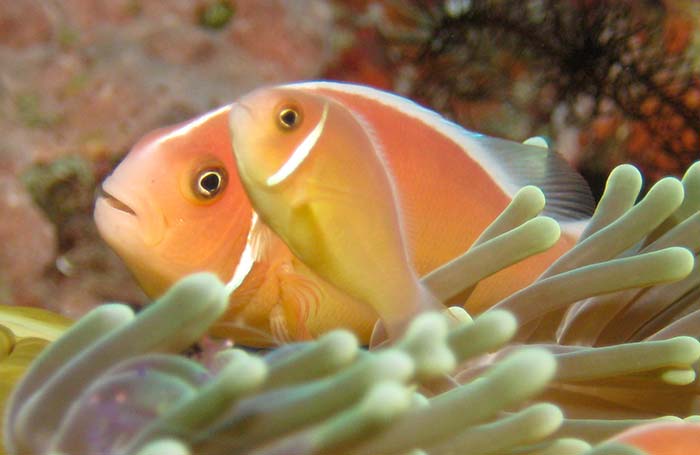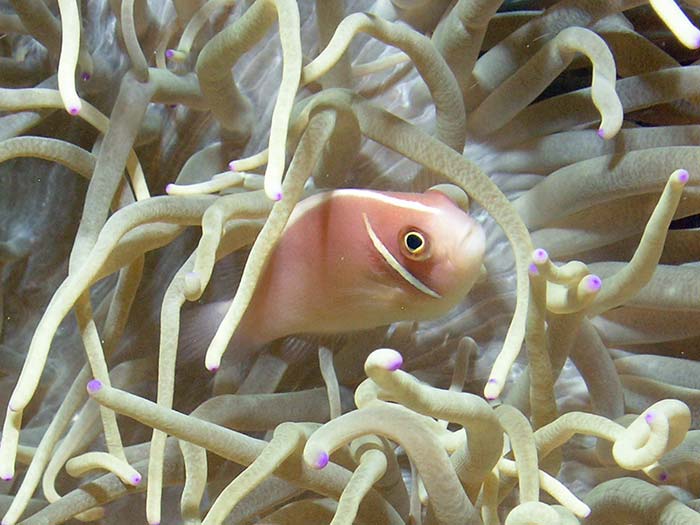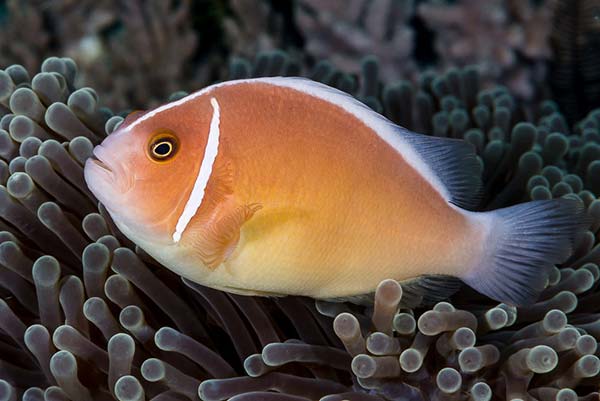Pink Skunk Clownfish 101: Care, Lifespan, Breeding & More
Posted by Miles Harrison on 02/01/2022
Last Updated on 10/08/2022
We use affiliate links and may receive a small commission on purchases.
The Pink Skunk Clownfish, also referred to as the Pink Skunk Anemonefish, is one of the more interesting anemonefish that exists in the hobby. This fish is easy to care for, has a peaceful personality, and is fun to observe in an aquarium.
It’s no wonder that these fish are some of the most popular saltwater fish. Their unique appearance easily stands out in a reef tank!
As is the case with all aquarium fish, you’ll want to be sure you have all of the right information needed to take care of this species. It’s easy to get lost in all of the misinformation that’s shared online, but don’t worry - we’re here to help.
In this post, we’ll cover everything there is to know about the Pink Skunk Clownfish. We’ll discuss their appearance, food, and diet requirements, and we’ll even discuss how to breed this wonderful species!
Species Summary
Pink Skunk Clownfish (A. perideraion) is a member of the Pomacentridae family. These fish are found swimming through the waters of Melanesia and the Great Barrier Reef. They’ve also been known to exist near the Ryukyu Islands of Japan and throughout the eastern Indian Ocean! They’re also the only anemonefish species that is found on both the west and east coasts of Australia.
In the aquarium hobby, these fish are highly sought after, largely due to their appearance and temperament. These fish have a distinct vertical white stripe along their dorsal ridge, and also have an additional vertical white stripe behind their eye.
These patterns are what make this species truly stand out amongst other anemonefish, such as the Snowflake Clownfish.
Best of all, the Pink Skunk Clownfish is relatively easy to care for and quite peaceful. Combined, all of these traits make this fish an excellent starter fish for aquarists new to saltwater fishkeeping.

Lifespan
Pink Skunk Clownfish have a long lifespan and have been documented to live for over 21 years in captivity.
As with all fish, the lifespan of these fish will shorten if you do not provide optimal care. Keeping consistent water parameters, and feeding a high-quality diet will ensure these fish can live a healthy life.
If you’re not prepared to house this species for such a long duration, you may want to stay clear of a Pink Skunk Clownfish, other species, such as the designer-bred Snowflake Clownfish only have a life expectancy of around 10 years.
Appearance
The Pink Skunk Clownfish’s appearance is one of a kind. While most clownfish have thick banded white stripes, as seen in species like the Ocellaris Clownfish, and Saddleback Clownfish. The Pink Skunk breaks the mold.
These fish are known for their orange/pinkish colored body and their vertical white stripes that run directly behind their eyes. Pink Skunks also have an additional white stripe that runs along their spine. When looking at anemonefish from above, it’s quite easy to spot a Pink Skunk due to this unique feature!
Their pectoral fins also match the color of their bodies, although portions of the fin will appear translucent.
These fish are quite slim, and their bodies taper down towards their tail fin. The front half of this fish is quite round. Its dorsal, anal, and tail fins all have a white translucent coloration.
Size
The average size of a Pink Skunk Clownfish is 4.5 inches in length. Males tend to be a bit smaller than females.
Most of the males you’ll find in captivity will be around 2.5 inches, and juveniles will be quite a bit smaller until they turn into adults, which is typically around the 2-year mark.
Pink Skunk Clownfish Care
Luckily for new aquarists, Pink Skunk Clownfish are some of the least demanding anemonefish in the hobby. It’s no wonder that they’re frequently recommended as beginner saltwater fish. However, you’ll still need to meet all of their needs to provide them with an optimal life. Let’s dig into this a bit further by starting with aquarium size!
Tank Size
The minimum tank size to keep a Pink Skunk Clownfish is 30 gallons. Although you’ll frequently come across guides that say this fish requires only 20 gallons, we strongly advise against this.
Like many other types of anemonefish, Pink Skunk Clownfish should be kept in pairs. While a 20-gallon aquarium may be fine for housing just one fish, it’s far too small for two.
If you plan on adding additional tankmates, you’ll want an even bigger tank. Keeping too many fish in a small aquarium means the aquarium is considered overstocked, a common precursor to poor water quality.
Water Parameters
Pink Skunk Clownfish are quite hardy, but you’ll still need to provide water parameters that closely resemble the conditions of their natural habitat. Providing optimal water quality will improve their health and lengthen their lifespan.
Aquarists that are successful with this species have one thing in common. They’re experts at maintaining optimal water conditions over a long period, and for a fish that can live for over 20 years, it’s a skill you’ll want to master as well!
- Water temperature: 72°F-78°F
- pH levels: 8.1 to 8.4
- Carbonate hardness: 8°-12° dKH
- Specific Gravity: 1.020-1.025
These levels can be maintained by performing weekly water changes. We recommend performing 15% water changes bi-weekly. If you plan on keeping corals (which we recommend!) you can perform 5% weekly water changes instead.

What To Include In Their Tank
Pink Skunk Clownfish love to swim throughout the aquarium and will appreciate an abundance of live rock, which you can use to create small caverns and tunnels for your fish to swim through.
However, these fish are called anemonefish for a reason! We strongly recommend providing anemones for your fish to rest in. Pink Skunk Clownfish will form a symbiotic relationship with an anemone. Witnessing this bond form in a home aquarium is an incredibly rewarding experience.
However, these fish are called anemonefish for a reason! We strongly recommend providing anemones for your fish to rest in. Pink Skunk Clownfish will form a symbiotic relationship with an anemone. Witnessing this bond form in a home aquarium is an incredibly rewarding experience.
It’s worth mentioning that Pink Skunk Clownfish are vulnerable to the stings of certain anemones. For this reason, we recommend the following anemones:
- Giant Carpet Anemone
- Long Tentacle Anemone
- Leathery Sea Anemone
- Magnificent Sea Anemone
However, these fish are called anemonefish for a reason! We strongly recommend providing anemones for your fish to rest in. Pink Skunk Clownfish will form a symbiotic relationship with an anemone. Witnessing this bond form in a home aquarium is an incredibly rewarding experience.
Since these fish prefer temperatures between 72°F-78°F, you’ll also want to be sure to include an aquarium heater that’s rated for your tank size. Temperatures below 72°F can quickly become dangerous for a Pink Skunk, so be sure to have a plan in case you experience a power outage!
Common Diseases
One of the most common diseases that Clownfish face is Brooklynella hostilis. This parasitic organism is so common in Clownfish it’s occasionally referred to as “Clownfish disease”. If you notice your Pink Skunk’s skin starting to turn cloudy, or your fish becoming lethargic, they may be suffering from this disease.
Treatment typically involves quarantining your fish and treating them with Ruby Reef Rally PRO.
After treatment, you can monitor your fish in a quarantine tank. Once one week has passed and they are no longer showing symptoms of Brooklynella, they can be returned to the main tank.
Brooklynella typically occurs when an infected fish is introduced into an existing aquarium. Always consider quarantining your fish and monitoring them for any potential diseases before adding them to your aquarium.
Another common disease is known as Flukes. Flukes are microscopic parasites that infect the gills and skin of a fish. Treatment for Flukes typically involves dipping the fish in freshwater and monitoring the fish to see if the parasites fall out of the fish. After performing multiple freshwater dips, your fish should be on the road to recovery!
Flukes are typically caused by poor water conditions. Maintaining excellent water conditions will ensure your fish have a strong immune system that can fight off parasitic diseases like Flukes.
Food & Diet
Pink Skunk Clownfish don’t have any special diet requirements and will accept high-quality live or frozen flake foods, pellets, frozen Mysis shrimp, and frozen brine shrimp.
These fish should be fed twice daily, and shouldn’t be fed more than what they can consume over a 2-minute feeding period.
In the wild, these Omnivorous fish will feed mostly on algae, larvae, small clams, and other gastropod fragments. Providing these fish with nutritious flake food will guarantee these fish get the nutrients needed to live a long and healthy life.
As a treat, you can supplement their diet with thawed frozen Bloodworms. Just be sure not to overfeed these fish, as excessive amounts of food can decay, resulting in harmful ammonia spikes!
Behavior & Temperament
These fish are mostly peaceful, but you may want to use caution when adding them to an aquarium with existing inhabitants. If the aquarium is not large enough, they may show signs of aggressive behavior, such as fin nipping.
We recommend adding Pink Skunk Clownfish as the first inhabitants of a newly established aquarium. This will allow the clownfish to establish territory, resulting in less aggressive behavior.
Pink Skunk Clownfish, similar to other types of clownfish, has a rather erratic swimming pattern. They’re always wiggling their bodies and moving side-to-side, it’s quite fun to watch!
Unfortunately, these fish are also known as jumpers. You’ll want to make sure you have a tight-fitting lid if you plan on keeping Pink Skunk Clownfish. Unless you possess the ability to resurrect fish, we highly recommend having a secure lid.
Pink Skunk Clownfish are highly active during the day, constantly exploring parts of the aquarium. However, at night, these fish will start becoming less active. These fish will typically hover in place, as they rest in preparation for the next day. It will appear as if your fish is undergoing some form of meditation, and maybe they truly are!
Tank Mates
Pink Skunk Clownfish will do well with other peaceful species. Given a large enough aquarium that meets the needs of any additional inhabitants, some potential options include:
- Flameback Angelfish
- Blotched Anthias
- Royal Gramma Basslets
- Pink Streaked Wrasse
- Blue Chromis
However, we strongly advise against keeping Pink Skunk Clownfish with other clownfish species. These fish will turn aggressive towards each other, and nobody wants to rehome a fish because of territorial disputes.
You should also use caution if you plan on having more than two Pink Skunk Clownfish. If you plan on keeping multiple pairs, make sure you have an aquarium large enough for these fish to establish their territories.
Just because they are all the same species, does not mean they are guaranteed to get along!
Breeding
If you’re interested in learning how to breed this species, you’re in luck! Although difficult, It is possible to breed Pink Skunk Clownfish in captivity.
Pink Skunks, like many other types of anemonefish, can change their sex at a whim. If the opportunity presents itself, a dominant fish will turn female. Courtship usually occurs after the Pink Skunk Clownfish are sexually mature, which is typically around 5 years of age.
If you notice your female Pink Skunk Clownfish’s belly starting to swell, it means your fish will spawn soon! Both male and female fish will start cleaning the base of an anemone in preparation for spawning.
Spawning will typically occur around mid-day, and once released, eggs can hatch within 8-10 days. We strongly recommend separating the eggs into a different aquarium to raise the fry.
Unfortunately, not all of the fry will survive this intense period. Reducing light intensity, and preventing any potential causes of stress will increase the odds that you’ll raise successful fry.
If you can keep the fry alive for at least 2-weeks, you’ll have successfully bred baby Pink Skunk Clownfish!
Frequently Asked Questions
How long do Pink Skunk Clownfish live?
The Pink Skunk Clownfish is long-lived, In captivity, these fish have been recorded to live for over 21 years!
Where are Pink Skunk Clownfish found?
Pink Skunk Clownfish can be found throughout the Great Barrier Reef and in the archipelago between Southeast Asia and Australia.
Where can I buy Pink Skunk Clownfish?
Pink Skunk Clownfish are occasionally sold on websites such as Light Fish, LiveAquaria , or hatcheries such as ORA . We recommend purchasing from a trusted breeder, as the fish will likely be accustomed to conditions found in a home reef aquarium.
What do you feed Pink Skunk Clownfish?
In the wild, these fish live off of various types of zooplankton, amphipods, and gastropod fragments. In a reef aquarium, Pink Skunk Clownfish do well with live feeder shrimp, brine shrimp, and flake food such as Seachem Nutridiet Tropical Flakes . Clownfish should be fed a minimum of twice per day.

In Summary
As you can see, the Pink Skunk Clownfish is a fish that has it all. Its peaceful personality, skunk-like appearance, and interesting behavior make this fish a favorite among saltwater aquarium hobbyists.
If you’re considering adding this fish to a new aquarium, or an existing tank, we hope that we’ve given you all of the knowledge needed to care for this species in the best way possible.
We hope that you enjoyed this post! We love to hear feedback from our readers. If you have any suggestions for improvements or additions, you can reach us any time by sending us an e-mail, we’d love to hear from you!
December's Giveaways on Light Fish








